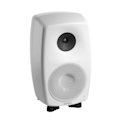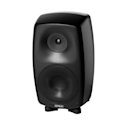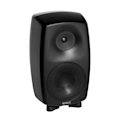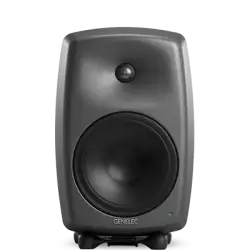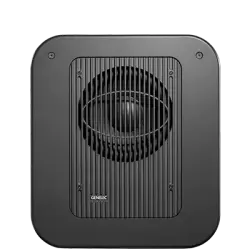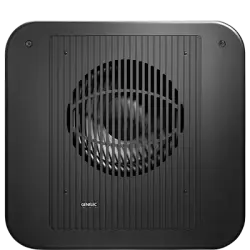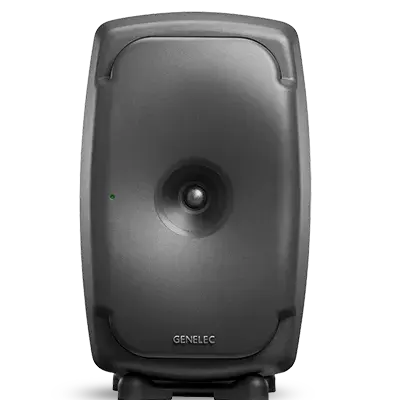8260A SAM™ Studio Monitor
A masterpiece of electro-acoustic design, the 8260A remains a milestone achievement in coaxial monitoring and mid-field precision.
The Genelec 8260A was in production between 2010 and 2019. It was replaced by the 8361A model.
Combining the unmatched detail and clarity of Genelec’s three-way, coaxial design with tremendous SPL and the innovation of Smart Active Monitoring, the 8260A has been an icon of the modern studio since it was launched.
The tri-amplified monitor employs a range of Genelec technologies to exceed the expectations of even the most demanding facilities. The ground-breaking Minimum Diffraction Coaxial (MDC™) driver and advanced Directivity Control Waveguide (DCW™) technology work in tandem to provide accurate imaging with outstanding clarity and definition to reveal inner details of your mix. Meanwhile, the world’s most advanced and adaptable monitoring technology is available in the shape of Smart Active Monitoring (SAM™). Genelec Loudspeaker Manager (GLM™) software allows for the fine adjustment of all monitor settings, while AutoCal™ compensates for detrimental room influences to perfectly calibrate your set-up for your listening environment.
A trusted icon of modern mixing, the 8260A can be found in mid-sized to large mixing rooms and broadcast facilities all over the globe.
8260A SAM™ Studio Monitor
Awards
PAR Excellence Award 2009
The Genelec 8260A studio monitor was awarded a PAR Excellence Award 2009.
Mix Magazine's Top-20 hits of AES 2009 Show
The 8260A studio monitor was included in the Mix Magazine's Top-20 hits of AES 2009 Show.
Resolution Awards 2010 - Monitoring
The 8260 studio monitor was awarded a Resolution Award 2010 in the "Monitoring" category.
Audio Media Gear of the Year 2010 - Outstanding & Innovative Product
Genelec 8260A studio monitor was awarded an Audio Media Gear of the Year 2010 award in the category "Outstanding & Innovative Product".
TEC (Technical Excellence and Creativity) Award 2010 - Studio Monitor Technology
The 8260 SAM™ Studio Monitor was awarded a TEC (Technical Excellence and Creativity) Award 2010 in the "Studio Monitor Technology" category.
MIPA (Musikmesse International Press Award) 2011 - Best Studio Monitor (Nearfield)
The multi-award winning Genelec 8260A3-way DSP loudspeaker system has added to its list of accolades with the recent addition of a MIPA (Musikmesse International Press Award) Award. The 8260A won through in the Studio Monitor (nearfield category) beating off tough opposition in a highly competitive field. The mipa award is the sixth major prize the 8260A has been awarded since its launch. Voted for by over 100 magazines from the worldwide music press, the mipa awards were presented at a special ceremony and party held during the Musikmesse/Prolight + Sound 2011. The mipa awards recognize the best musical instruments and audio equipment of 2010/2011, across forty separate categories. “We knew we had a winner when we launched the 8260A but we had no idea how many people would agree with us!” says Terho Savolainen, Marketing Manager, Genelec. “The 8260A has swept the board across the awards and its reputation keeps growing. We are grateful that our industry peers agree with our customers who have come to see the 8260A as the leading monitor on the market.” More than 300 international representatives of manufacturers and distributors of musical instruments and audio equipment got together for the 12th mipa awards show, including guests from the USA, Canada, Japan, Brazil, South Africa, Russia, Poland, Great Britain, Italy, France, Greece, The Netherlands, Belgium, Luxemburg, Sweden, Denmark, Austria, Switzerland and Germany. 20118260A - Musik Messe International Press Award (MIPA) 2011 - Best Studio Monitor
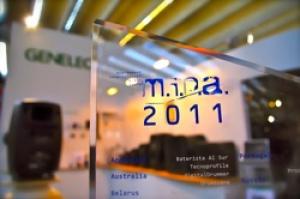
Technical Specifications

SPL
113 dB

Amplifier Power
150 W Bass (Class AB) + 120 W Midrange (Class AB) + 120 W Treble (Class AB)

Frequency Response
23 Hz - 40 kHz ("-6 dB")

Accuracy of Frequency Response
± 1 dB (29 Hz - 20 kHz)

Dimensions
H 593 x W 357 x D 347 mm, with Iso-Pod™ (view in inches)

Weight
27.5 kg / 60.6 lb

Connections
1 x XLR Analog Input
1 x XLR AES/EBU Input
1 x XLR AES/EBU Output
2 x RJ45 Control
8260 product specifications
Technical Specifications
A masterpiece of electro-acoustic design, the 8260A remains a milestone achievement in coaxial monitoring and mid-field precision.
The Genelec 8260A was in production between 2010 and 2019. It was replaced by the 8361A model.

System Specifications
Frequency Response
29 Hz - 20 kHz (± 1 dB)
Low cutoff -6dB
23 Hz
High cutoff -6dB
40 kHz

SPL
Peak SPL Maximum peak SPL output per pair on top of console at 1 m with music material.
≥123 dB
Short term max SPL Maximum short term sine wave SPL output at 1 m on axis in half space, averaged from 100 Hz to 3 kHz.
≥113 dB
Self-generated noise
Self-generated noise Self generated noise level in free field at 1 m on axis (A-weighted).
≤5 dB SPL
Weight
Weight27.5 kg (60.6 lb)
Dimensions
Height
570 mm
Height with Iso-Pod
593 mm
Width
357 mm
Depth
347 mm
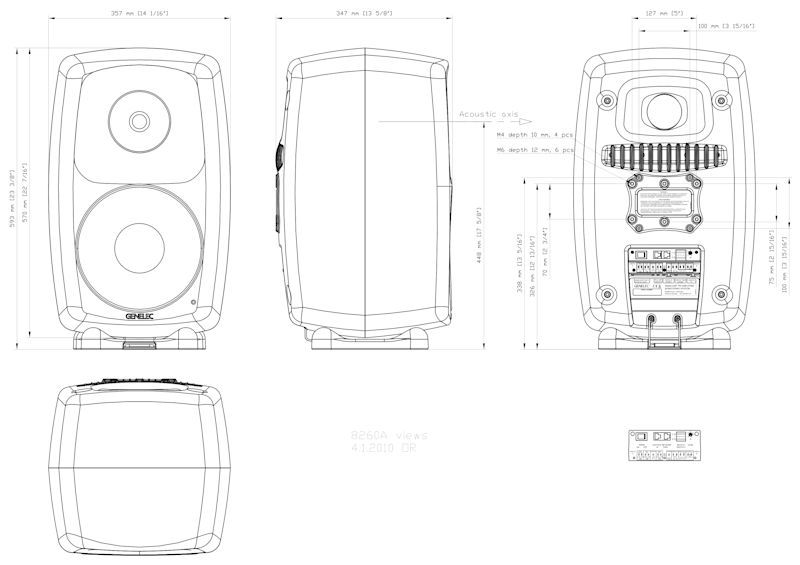
Enclosure
Enclosure material
Die cast aluminium
Enclosure type
Reflex port
Directivity

Harmonic distortion
Group delay
The latency at high frequencies from the input to the acoustic output, measured in the analog input:
Extended Phase Linearity in GLM set to OFF
4.9 ms
In Genelec performance graphics, the time of converting the from an electronic input signal to the acoustic output in a Genelec monitor is described by two factors – latency and group delay. The group delay factor can be read in the graphics for a specific frequency. The total frequency-specific input-to-output delay is a sum of the latency and group delay factors. To understand the significance of this total delay, consider that moving a loudspeaker away by 1 meter creates an additional delay of about 3 ms.
Amplifier Section
Amplifiers
150 W Class AB
120 W Class AB
120 W Class AB
Mains voltage
100, 120, 220 or 230VAC 50/60Hz according to region
Power consumption
Idle
≤26 W
Full output
330 W
Signal processing section
Connectors
Input Analog signal input connector XLR female (10 kOhm input load impedance).
Input XLR female (conforms to IEC 60958-4)
Output XLR male (conforms to IEC 60958-4)
2 x Control Two CAT5 (RJ45) GLM Network connectors for computer control using the Genelec Loudspeaker Manager (GLM) software.
Product Variants
Product codes
Compatible Accessories
Product codes
For even more technical details please see product operating manual.
Documentation
Documents
Operating Manual 8260A Brochure 8260A SAM™ Series Full Line Catalogue In-Room Product Performance Immersive Solutions BrochureDownloads
Line Drawings (PDF) 8260A Line Drawings (DWG) 8260A 8260A Technical White Paper 8260A - Technical Article (Resolution Magazine) 8260A - Simulation File (CLF)Reviews
Hörerlebnis Magazin: Analytic wird Genuss, June 2014 (DE) Tekniikan Maailma, March 2012 (FI) Studio Magazin, February 2010 (DE) Visio, March 2010 (FI) Hifimaailma, March 2010 (FI) Sound & Recording Magazin, April 2010 (DE) Bonedo Magazin (online): Genelec 8260A DSP Test - SIZE MATTERS!, May 2010 (DE) Music Tech Magazine, June 2010 (GB) Pro Sound News Magazine: Genelec 8260A Triamplified Active DSP Loudspeaker, December 2011 (US) Audio Media, September 2010 (GB) Amazona.de: GENELEC 8260A DSP, September 2010 (DE) Monitor, October 2010 (SE) Mix Magazine, October 2010 (US) Musikermagasinet, December 2010 (SE) Lyd & Bilde, December 2010 (NO) Ljud & Bild (online): Genelec 8260A, January 2011 (SE) Sound on Sound Magazine: Genelec 8260A Three-way DSP Reference Monitors, January 2011 (UK) Stereoplay online Magazin (PDF), July 2011 (DE)"Jüngster (wenn auch nicht kleinster) Zuwachs der finnischen Monitorschmiede ist der aktive digitale 3-Wege Koaxial-Nahfeldmonitor Genelec 8260A DSP. Mit einem extrem weiten und linearen Frequenzgang versucht auch er, genau diesem Leitmotiv Folge zu leisten. Ob er das schafft, erfahrt ihr hier in gewohnter Manier!"
-Felix Klostermann, the author of the review article
Bonedo Magazin's (DE) online review "Genelec 8260A DSP Test - SIZE MATTERS!" of 8260 active studio monitor. The review was published in May 2010, and is written by Felix Klostermann. It is available in German language.
Read the full review here.
Music Tech Magazine (GB) reviewed the Genelec 8260A active studio monitor in June 2010 (issue 87).
Music Tech Magazine (GB) reviewed the Genelec 8260A active studio monitor in May 2010.
The Pro Sound News Magazine's article reviews the Genelec 8260A studio monitor. The review article is written by Frank Wells and it was published in December 2011.
The Pro Sound News Magazine's article reviews the Genelec 8260A studio monitor. The review article is written by Frank Wells and it was published in December 2011.
Read the full article here.
"Die neuste Entwicklung, die Genelec voller Stolz auf der Musikmesse 2010 präsentierte, sind die 8260A DSP. Es handelt sich dabei um die bislang größte Box mit Aluminiumgehäuse und DSP-Einheit, die obendrein noch als Dreiwege-System ausgelegt ist."
-T. Walter, the author of the review article
The test review of amazona.de "TEST: GENELEC 8260A DSP" is written by T. Walter and it was published in September 2010.
Read the full review in German here.
"Marknaden skrek efter en kompakt trevägsmonitor från Genelec. Här är den finska tillverkarens första koaxialhögtalare!"
-Audun Hage, the author of the review article
Ljud & Bild's online review of 8260A studio monitors in Swedish. The review was published in January 2011.
"They may have the familiar Genelec appearance and family sound, but these big beasts bring some new ideas to the table."
-Hugh Robjohns, the author of the review article
Sound on Sound Magazine's (UK) review of Genelec 8260A Three-way DSP Reference Monitors. The review was published in January 2011, and it is written by Hugh Robjohns.
"Der finnische Profiausrüster Genelec paart im 8260 einen modernen Koax mit komplexer Elektronik."
-Wolfram Eifert, the author of the review article
Stereoplay online Magazine's (DE) review of Genelec 8260A Studio Monitor. Written by Wolfram Eifert. The review was published in July 2011 and it is available in German.
Key Technologies

Active Crossovers

Directivity Control Waveguide (DCW™) Technology

Iso-Pod™ Stand

Minimum Diffraction Coaxial (MDC™) Driver Technology

Minimum Diffraction Enclosure (MDE™) Technology

Optimised Amplifiers

Protection Circuitry

Reflex Port Design

Smart Active Monitoring (SAM™) and GLM™ calibration technology

Versatile Mountings
Active crossover operating at low signal levels.

Audio electronic crossovers allow the audio signal to be split into separate frequency bands that are separately routed to individual power amplifiers, which are then connected to specific transducers optimised for a particular frequency band.
Active crossovers come in both digital and analogue varieties. Genelec digital active crossovers include additional signal processing, such as driver protection, delay, and equalisation.
Genelec analogue active crossover filters contain electronic components that are operated at low signal levels suitable for power amplifier inputs. This is in contrast to passive crossovers that operate at the high signal levels of the power amplifier's outputs, having to handle high currents and, in some cases, high voltages.
In a typical two-way system the active crossover needs two power amplifiers — one for the woofer and one for the tweeter.
The active crossover design offers multiple benefits:
- The frequency response becomes independent of any dynamic changes in the driver's electrical characteristics or the drive level.
- There is increased flexibility and precision for adjusting and fine-tuning each output frequency response for the specific drivers used.
- Each driver has its own signal processing and power amplifier. This isolates each driver from the drive signals handled by the other drivers, reducing inter-modulation distortion and overdriving problems.
- The ability to compensate for sensitivity variations between drivers.
- The possibility to compensate for frequency and phase response anomalies associated with a driver’s characteristics within the intended pass-band.
- The flat frequency response of a high-quality active loudspeaker is a result of the combined effect of the crossover filter response, power amplifier responses and driver responses in a loudspeaker enclosure.
Using the active approach enables frequency response adjustments and optimisation of the full loudspeaker system, placed in various room environments, without expensive external equalisers. The end result is a simpler, more reliable, efficient, consistent and precise active loudspeaker system.
Directivity Control Waveguide (DCW™) for flat on and off-axis response.

A revolutionary approach was taken by Genelec in 1983 with the development of its Directivity Control Waveguide (DCW™). We have developed and refined this technology over more than 30 years to greatly improve the performance of direct radiating multi-way monitors.
The DCW technology shapes the emitted wavefront in a controlled way, allowing predictable tailoring of the directivity (dispersion) pattern. To make the directivity uniform and smooth, the goal is to limit the radiation angle so that the stray radiation is reduced. It results in excellent flatness of the overall frequency response as well as uniform power response. This minimises early reflections and provides a wide and controlled listening area achieving accurate sound reproduction on and off-axis.
Minimised early reflections and controlled, constant directivity have another important advantage: the frequency balance of the room reverberation field is essentially the same as the direct field from the monitors. As a consequence, the monitoring system's performance is less dependent on room acoustic characteristics.
Sound image width and depth, critical components in any listening environment, are important not only for on-axis listening, but also off-axis. This accommodates not only the engineer doing their job, but also others in the listening field, as is so often the case in large control rooms.
DCW™ Technology key benefits:
- Flat on and off-axis response for wider usable listening area.
- Increased direct-to-reflected sound ratio for reduced control room coloration.
- Improved stereo and sound stage imaging.
- Increased drive unit sensitivity up to 6 dB.
- Increased system maximum sound pressure level capacity.
- Decreased drive unit distortion.
- Reduced cabinet edge diffraction.
- Reduced complete system distortion.
Vibration decoupling Iso-Pod™ stand improves sound image definition.

Although it is advisable to use sturdy and stable floor stands together with free-standing loudspeakers, a very common solution is to place loudspeakers directly on a table or on a console meter bridge.
This causes several detrimental side effects. Aiming of the loudspeaker axis towards the listener is rarely implemented, also, unwanted mechanical vibration do propagate from the loudspeaker to the mounting surface, and first order reflection on the work surface causes comb filtering and hence ripples in the frequency response.
To solve these very common problems Genelec developed an efficient and very practical solution. We designed a loudspeaker stand called Iso-Pod™ - Isolation Positioner/Decoupler that is attached to the aluminium enclosure. It has four shallow feet and it is made from special lossy rubber-like material. It is firmly attached to the enclosure so that it can be slid along the curved bottom or side surface to allow for a ±15° tilt of the loudspeaker.
The loudspeakers’ acoustical axis can then be pointed precisely towards the listener by adjusting the enclosure’s inclination with the Iso-Pod. The vibration isolation and damping properties reduce midrange coloration caused by unwanted vibration transmitted to supporting surfaces.
This innovative solution is an integral part of Genelec loudspeaker design and provides clear benefits in usability and sound quality.
Minimum Diffraction Coaxial (MDC™) Driver Technology reproduces outstanding sound image.

Typical coaxial designs suffer from a somewhat ragged frequency response due to diffraction problems inherent in their unrefined design. However, crossover issues due to the non-coincident location of sources are solved with a coaxial configuration, so a coaxial solution without diffraction problems is the ideal. Genelec’s Minimum Diffraction Coaxial (MDC™) Driver Technology provides all the benefits of coaxial design while overcoming the typical shortages – solving the diffraction problem.
The first step is to minimise the cone displacement, in other words to limit the low frequency bandwidth of the driver. Next, is to avoid all sources of diffractions. The main structure of the MDC design consists of an integrated MF diaphragm-suspension tweeter construction. The visible part of the coaxial driver is formed by the curved flexible skin with the dome tweeter assembly in its centre. The inner section joins the cone to the tweeter without any acoustical discontinuity, and the outer one does the same between the cone and the driver chassis.

As there are no acoustically observable discontinuities between the tweeter and the cone, just a smooth surface, there is no diffraction either. The cone profile is very carefully optimised to form an integrated directivity control waveguide for the tweeter radiation. The driver outer edge is terminated to a normal Genelec DCW in order to control the dispersion of midrange radiation as well. The response is very smooth both on and off-axis and free from any anomalies – and directivity is well controlled.
This breakthrough in coaxial design provides improved imaging and overall sound quality on and off-axis, extremely smooth frequency response leading to outstanding clarity and definition of the inner details of the music.

The main novelties of Genelec combined DCW™ and MDC™ designs:
- Diffraction-free joint between tweeter and midrange diaphragm.
- Diffraction-free joint between midrange diaphragm and DCW™ waveguide.
- A proprietary midrange diaphragm technology – laminate structure combining a rigid cone and elastic, lossy materials including the suspension itself.
- A midrange diaphragm-suspension pair which cancels all possible non-linearity.
Advantages:
- Smoother frequency response.
- Ensures the drivers couple coherently over their full operating bandwidth.
- Significantly improves the directivity control in the critical frequency range.
- Provides balanced suspension dynamics to minimise acoustic distortion.
- Optimises the use of the front baffle area while maintaining the 8000 Series appearance and benefits.
Minimum Diffraction Enclosure (MDE™) for uncoloured sound reproduction.

A common problem with standard free-standing loudspeakers is that the front baffle discontinuities cause diffractions and the loudspeaker sharp corners act as secondary sources through reflections.
In order to improve the flatness of the frequency response and the power response of free standing loudspeaker systems, Genelec have designed a highly innovative enclosure optimized to match the properties of the monitor drivers, featuring rounded edges, and gently curved front and sides. In addition to achieving an unsurpassed flatness of the frequency response, the enclosure having minimum diffractions yields superb sound stage imaging qualities.
To achieve such a smooth and elegantly curved cabinet surface and to reduce the outer dimensions of the enclosure, maximising at the same time the internal volume for improved low frequency efficiency, we designed a cabinet made off die-cast aluminium. Aluminium is lightweight, stiff and very easy to damp to yield a “dead” structure. The cabinet walls can be made fairly thin, providing at the same time good EMC shielding and excellent heat sink for the power amplifiers. Die-casting is made in two parts, front and rear, and they are easy to separate for potential servicing needs.
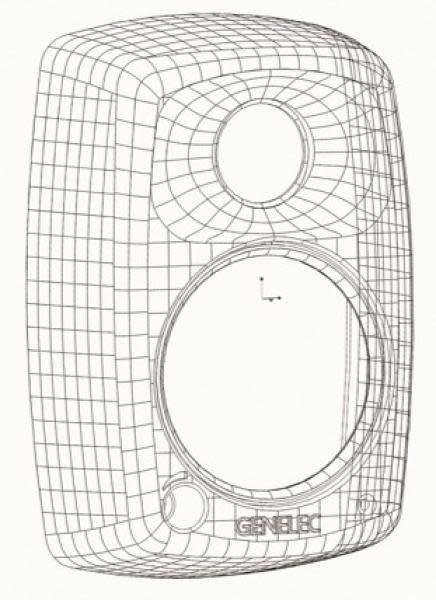
The DCW waveguide has been integrated in the MDE aluminium enclosure to provide improved control of the loudspeaker’s directivity. Basically, the low frequency limit for constant directivity is determined by the size of the waveguide, so the larger the surface the better the control. With a very controlled off-axis radiation, the listening window becomes consistent, which is of utmost importance with multi-channel audio monitoring. Controlled directivity also reduces possible first order reflections on surfaces near the loudspeaker, helping to provide consistent audio reproduction in different acoustical environments. In fact, the entire front baffle is gently curved and the acoustically transparent grilles are part of the outer cabinet aesthetics, blending perfectly with the various other curved surfaces.

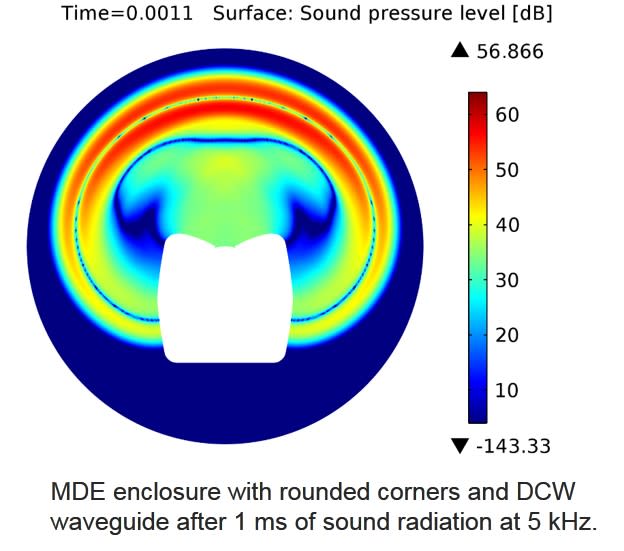
Each transducer is driven by its own optimised amplifier.

Audio electronic crossovers allow to split the audio signal into separate frequency bands that can be separately routed to individual power amplifiers, which are then connected to specific transducers optimised for a particular frequency band.
In a typical 2-way loudspeaker system, the active crossover needs two power amplifiers — one for the woofer and one for the tweeter. The power amplifiers are connected directly to the drivers of an active loudspeaker, resulting in the power amplifier’s load becoming much simpler and well known. Each driver-specific power amplifier has only a limited frequency range to amplify (the power amplifier is placed after the active crossover) and this adds to the ease of design.
The active design principle offers multiple benefits:
- The power amplifiers are directly connected to the speaker drivers, maximising the control exerted by the power amplifier’s damping on the driver’s voice coil, reducing the consequences of dynamic changes in the driver electrical characteristics. This may improve the transient response of the system.
- There is a reduction in the power amplifier output requirement. With no energy lost in the passive crossover filter components, the amplifier power output requirements are reduced considerably (by up to 1/2 in some cases) without any reduction in the acoustic power output of the loudspeaker system. This can reduce costs and increase audio quality and system reliability.
- No loss between amplifier and driver units results in maximum acoustic efficiency.
- Active technology can achieve superior sound output vs. size vs. low frequency cut-off performance.
- All loudspeakers are delivered as a factory aligned system (amplifiers, crossover electronics and enclosure-driver systems).
Sophisticated drive unit protection circuitry for safe operation.

When working in critical audio production environments it is essential that monitoring systems remain reliable and functional at all times. One of the main reasons behind Genelec’s excellent success in broadcasting environments is the reliability of our products and a key element behind the reliability is the internal protection circuitry found in all products since 1978.
The protection circuitry prevents driver failures by detecting signal levels, and in case of sudden peaks or constantly too high levels, taking the signal level down automatically. Of course this feature does not affect the sound quality in any way when working within the specifications of the loudspeaker, but only prevents inadequate input signals from breaking the loudspeaker.

Protection circuitry features and benefits:
- Reduces the output level when required, (e.g. when driver voice coil temperature reaches the safe limit), which highly improves system reliability.
- Appropriate protection circuitry design in every loudspeaker and subwoofer enables the maximisation of system output sound level.
Advanced reflex port design for extended low frequency response.

Genelec’s choice for vented, or reflex, enclosures dates back to the S30 model, the first Genelec product from 1978. Port performance has been improved and refined over the years with the aim to increase the woofer’s low frequency extension and sound pressure level capability to provide outstanding bass articulation and definition.
Both driver and vent contribute to the total radiation of a reflex enclosure. Most radiation comes from the driver, but at the vent-enclosure resonant frequency the driver displacement amplitude is small and most of the radiation comes out of the vent.
To minimise the air speed in the tube, the cross sectional area of the vent should be large. This in turn means that the vent tube has to be long which presents quite a design challenge.
The long, curved tube maximises airflow so deep bass can be reproduced without compression. The reflex tube terminates with a wide flare located on the rear of the enclosure, minimising port noises and providing excellent bass articulation.
The curvature of the tube has also been carefully designed to minimise any audible noise, compression or distortion. The inner end of the tube has proper resistive termination to minimise once again audible chuffing noise and air turbulence.
Proper reflex port design allows also to significantly reduce the woofer’s displacement, improving the linear low frequency output capacity.
Networked Smart Active Monitor (SAM™) Systems feature automatic calibration to the environment.

Now, more than ever, audio productions are engineered in tighter, more confined working environments. This increases acoustic problems and lowers the reliability of monitoring. At the same time, an audio engineer's need to trust a reliable and precise monitoring system that reproduces sound neutrally and without distortion has not changed.
Built upon the solid electro-acoustic foundations of our 1200, 8000 and 7000 Series products, Genelec SAM Systems are today’s most advanced and flexible monitoring solutions. They are an indispensable tool for audio professionals, as they automatically adapt to the acoustic environment and correct for level, delay and room anomalies. SAM Systems are controlled using Genelec's proprietary Loudspeaker Manager (GLM™) network and software, enabling you to build a highly flexible and reliable monitoring system.
GLM is a highly intuitive and powerful monitor control networking system that manages connectivity to all SAM studio monitors and subwoofers on the network. GLM software features adjustment of level, distance delay and flexible room response compensation equalisation with our state-of-the-art, highly robust AutoCal™ 2 algorithm automated calibration system. All parameters and settings are stored in system setup files or saved in each individual monitor or subwoofer, if the GLM network needs to be disconnected.
Also, all acoustical features of SAM Systems can be optimised and tailored for different working styles or client demands. Additionally, even if the monitors or the production projects move between rooms, you can expect SAM technology to provide the highest consistency in monitoring, providing neutral soundstage imaging with low distortion – in each environment.
Genelec SAM Systems offer a comprehensive, solution-oriented, intelligently networked product range supporting analogue and digital signals in virtually any working environment.
Versatile mounting options for all installation needs.

In addition to perfect acoustical design and advanced tailoring options to optimize the loudspeaker’s behaviour to the room environment, Genelec loudspeakers offer a variety of mounting options for easy installation in different applications.
Our wide range of accessories and fixed mounting points on the back of our aluminium enclosure products offer solutions to all common installation situations. M6 support points have been integrated in the die-cast enclosure for wall and ceiling mounts.
Some models also feature a 3/8” thread at the bottom of the enclosure to fit a robust microphone stand. Other larger and heavier models feature M10 fixing points. Special floor stand plates have been designed in order to fit the Iso-Pod stand that is part of our product design.
With these features our loudspeakers have found their way to a variety of applications beyond the professional audio and studio world, for example in commercial and AV installation projects as well as in home environments all around the world.

















